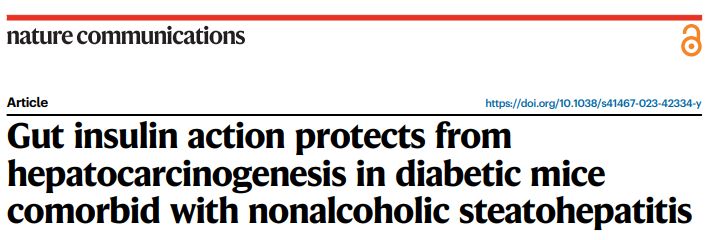Preventing Liver Cancer by Improving the Intestinal Dysbiosis
Today, we would like to introduce a study case of drug efficacy evaluation study using our mouse model of liver cancer caused by chronic liver disease (MASH/NASH). In this studies using our liver cancer model mice, it was found that not only the liver but also the intestines are important target organs in the treatment of liver cancer.
New report ► Gut insulin action protects from hepatocarcinogenesis in diabetic mice comorbid with nonalcoholic steatohepatitis
(Soeda K et al., Nat Commun. 2023) PMID: 37852976

Previous liver cancer therapies have focused on the liver, but this is the first report of a new liver cancer therapy that focuses on dysbiosis of the intestine to treat liver cancer.
Administration of Insulin to mice models of liver cancer not only improves blood insulin levels, but also improves the gut microbiota changes and leaky gut associated with MASH/NASH, and significantly reduced the number and size of liver cancer tumors.
In addition to the analysis items performed in this study, this mouse model allows us to evaluate the survival rate (OS), analyze tumor number and size in-life by CT, and perform histopathological analysis such as expression of the cancer marker glutamine synthase.
Therefore, it was shown that those who are focusing on dysbiosis or intestinal diseases can evaluate the drug efficacy against liver cancer derived from chronic liver diseases as another indication by using our liver cancer model mice.
While viral hepatitis is the main cause of HCC, it is expected that the number of viral hepatitis related cases can be decreased via vaccination (Chang, et al. Gastroenterology. 2016). On the other hand, MASH/NASH is considered a risk factor for liver cancer by causing increased oxidative stress and abnormalities in the immune and metabolic systems in the liver, and there are currently no prevention or treatment methods for MASH/NASH. Therefore, as the number of patients with MASH/NASH increases, the number of patients with MASH/NASH-induced liver cancer is expected to continue to rise (Estes, et al. Hepatology. 2018; Llovet et al., Nat Rev Dis Primers. 2021). Therefore, it is of the utmost importance that research and development be conducted to discover a treatment that can reduce the incident rate of MASH/NASH derived cancer.
And your gut-targeted compounds can increase their value in the liver disease drug market by evaluating their efficacy in liver cancer. Our liver cancer model is optimal for preclinical studies for this purpose.
Is anyone interested in expanding the indication from drug discovery focused on dysbiosis and bowel disease to liver cancer related to MASH/NASH?
How about evaluating the efficacy of your test substances, such as fecal microbiota transplantation (FMT), bacterial cocktail, probiotics, small molecule, phage cocktail, kampo medicine, functional ingredients and etc., on liver cancer using our liver cancer model mice?
For more information or to request more materials, please feel free to contact us.
